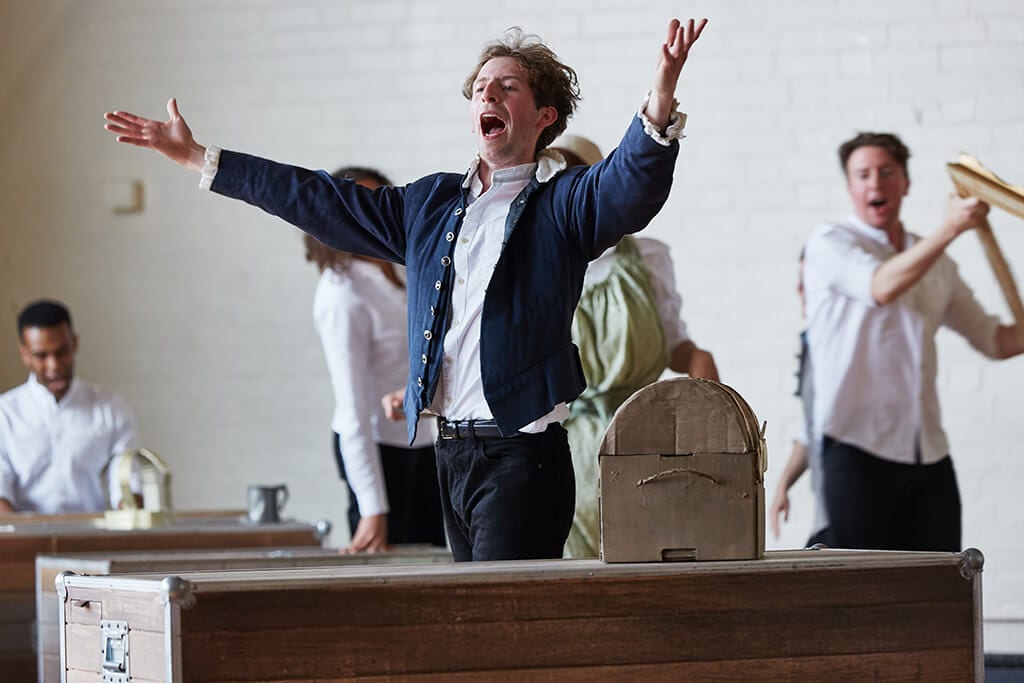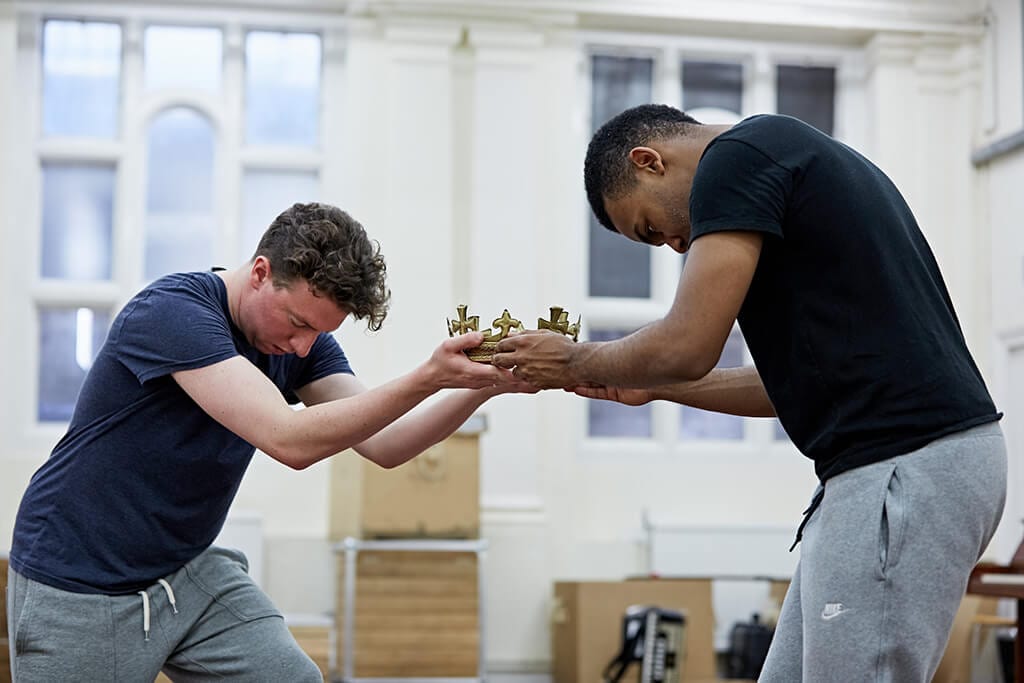Royal Shakespeare Company has a cunning plan to attract young audiences to the Bard’s tricky history plays: use headstrong Hal’s path to kingship, an engaging troupe of young actors and some great Horrid Histories fighting and gore, plus swords, crowns and lots of shouting. Tour it round schools and sympathetic theatres and sprinkle audience participation of pantomime proportions (including shout-outs and birthdays) and you have a convincing recipe. Even as we take our seats the performers are among us; spreading props, reassurance and jokes. My young neighbour Josie (8 years) is intrigued to be entrusted with a convincing Crown of England.
The house lights stay up to keep us safely in the world of ‘now’ as we are introduced to the world of ‘then’ when we are taught to revel with Sir John (“How now, Mad Wags?!”) and sing drinking songs (Blair Mowat’s music is beautifully judged). We join the action by shooting arrows at the French (‘Hiss!’) and perform our duty to St George like bold knights. We are ‘amazing’ and after bouncing up and down on King Henry’s orders we pause in an awed hush to let Josie process down the aisle and place her crown on its rightful cushion. The collective drum roll and applause confirm the crown’s centrality to what follows. Any kid taking away the notion that Henry V is about who wears the Crown of England won’t be too far from Shakespeare’s intent, after all.
The ensemble provides their own stage management and a picture frame convention allows characters a ‘freeze frame’ moment to introduce themselves before they launch into the action, a thoughtful touch to assist a young audience, especially when actors double up parts and names are not straightforward (Poins!). Appropriately for travelling players, Hull Truck’s performing space is littered with removal trunks. Ingenious openings, wheels and contents mean Simon Anthony Wells’ designs transform these into an array of thrones, taverns, battlefields and braziers and they’re exploited to the full in some terrific fights. Hotspur and Hall wrestle and hurl themselves on, over, under and around them in a magnificently choreographed showdown (Fights: Rachel Bown-Williams/Ruth Cooper-Brown).
We experience the characters physicality at all levels, whether Falstaff’s flab (the audience howl their agreement as Sheriff (Miller) judges him ‘fat as butter’), or the crown itself – rather too large for Hal’s head, a nice metaphor for his rookie state. If Henry IV’s elegant language on his deathbed is lost on Josie, Prince Hal appropriating a crown too large for him and getting told off for it, makes it clearer. There are moments when the density of the verse makes me wonder whether Owen Horsley couldn’t have cut even more ruthlessly for this age group. His edit and direction doesn’t pull back on the complex concepts and language – this is not a production that can be accused of dumbing down – but with a versatile orchestrated troupe like this cast, the opportunity is occasionally missed to trim Hal’s speeches and ‘show not tell’.
But only occasionally! The action is suitably whirl-wind, fitting three full plays into 70 minutes. Poins(Quinn) introduces his mad plot to mock Falstaff (Yadoo) and we’re off – drawing the Prince (Bassindale) dangerously close to thieving. We hurtle from East Cheap where a delightful Mistress Quickly (Abbott) rolls Shakespeare’s metre into a delicious West Indian patois to court and the Dauphin’s balls in an instant. Each plot twist and revelation is articulated by a trombone or piano or accordion, and there is scarcely a moment to catch breath. Bassindale (Hal) and Yadoo (Henry IV) soon work up a sweat sweeping from palace to the fray, and theirs is the toughest challenge – to make sense of difficult metaphors and concepts and not delay the hectic pace. At moments, their gurning and gestures to articulate meaning become rather too cartoon for me, but both have an engaging generous style which delights the young audience and inspires a lusty ‘God for Harry!’ at the right moment.
This is a smashing piece of theatre and great fun and deserves to pull lots of its target audience (and their mums and dads) to unpick Shakespeare’s challenging language through some of his most engaging characters.



